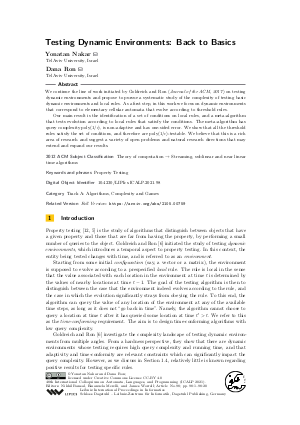Testing Dynamic Environments: Back to Basics
Authors Yonatan Nakar, Dana Ron
-
Part of:
Volume:
48th International Colloquium on Automata, Languages, and Programming (ICALP 2021)
Part of: Series: Leibniz International Proceedings in Informatics (LIPIcs)
Part of: Conference: International Colloquium on Automata, Languages, and Programming (ICALP) - License:
 Creative Commons Attribution 4.0 International license
Creative Commons Attribution 4.0 International license
- Publication Date: 2021-07-02
File

PDF
LIPIcs.ICALP.2021.98.pdf
- Filesize: 0.93 MB
- 20 pages
Document Identifiers
Related Versions
- Full Version https://arxiv.org/abs/2105.00759
Subject Classification
ACM Subject Classification
- Theory of computation → Streaming, sublinear and near linear time algorithms
Keywords
- Property Testing
Metrics
- Access Statistics
-
Total Accesses (updated on a weekly basis)
0Document
0Metadata
Abstract
We continue the line of work initiated by Goldreich and Ron (Journal of the ACM, 2017) on testing dynamic environments and propose to pursue a systematic study of the complexity of testing basic dynamic environments and local rules. As a first step, in this work we focus on dynamic environments that correspond to elementary cellular automata that evolve according to threshold rules. Our main result is the identification of a set of conditions on local rules, and a meta-algorithm that tests evolution according to local rules that satisfy the conditions. The meta-algorithm has query complexity poly(1/ε), is non-adaptive and has one-sided error. We show that all the threshold rules satisfy the set of conditions, and therefore are poly(1/ε)-testable. We believe that this is a rich area of research and suggest a variety of open problems and natural research directions that may extend and expand our results.
Cite As Get BibTex
Yonatan Nakar and Dana Ron. Testing Dynamic Environments: Back to Basics. In 48th International Colloquium on Automata, Languages, and Programming (ICALP 2021). Leibniz International Proceedings in Informatics (LIPIcs), Volume 198, pp. 98:1-98:20, Schloss Dagstuhl – Leibniz-Zentrum für Informatik (2021)
https://doi.org/10.4230/LIPIcs.ICALP.2021.98
BibTex
@InProceedings{nakar_et_al:LIPIcs.ICALP.2021.98,
author = {Nakar, Yonatan and Ron, Dana},
title = {{Testing Dynamic Environments: Back to Basics}},
booktitle = {48th International Colloquium on Automata, Languages, and Programming (ICALP 2021)},
pages = {98:1--98:20},
series = {Leibniz International Proceedings in Informatics (LIPIcs)},
ISBN = {978-3-95977-195-5},
ISSN = {1868-8969},
year = {2021},
volume = {198},
editor = {Bansal, Nikhil and Merelli, Emanuela and Worrell, James},
publisher = {Schloss Dagstuhl -- Leibniz-Zentrum f{\"u}r Informatik},
address = {Dagstuhl, Germany},
URL = {https://drops.dagstuhl.de/entities/document/10.4230/LIPIcs.ICALP.2021.98},
URN = {urn:nbn:de:0030-drops-141672},
doi = {10.4230/LIPIcs.ICALP.2021.98},
annote = {Keywords: Property Testing}
}
Author Details
References
-
D. Burraston and E. Edmonds. Cellular automata in generative electronic music and sonic art: a historical and technical review. Digital Creativity, 16(3):165-185, 2005.

-
Bastien C. and Michel D. Cellular Automata Modelling of Physical Systems. Cambridge University Press, 1998.

-
P. P. Chaudhuri, D. R. Chowdhury, S. Nandi, and S. Chattopadhyay. Additive Cellular Automata Theory and Applications. Vol. 1. IEEE Press, 1997. IEEE Press advances in circuits and systems series.

-
M. Cook. Universality in elementary cellular automata. Complex systems, 15(1):1-40, 2004.

-
O. Goldreich, S. Goldwasser, and D. Ron. Property testing and its connection to learning and approximation. Journal of the ACM, 45(4):653-750, 1998.

-
O. Goldreich and D. Ron. On learning and testing dynamic environments. Journal of the ACM, 64(3):1-90, 2017.

-
L. Kier, C. Cheng, and P. Seybold. Cellular automata models of chemical systems. SAR and QSAR in Environmental Research, 11(2):79-102, 2000.

-
A. Mustafa, A. Heppenstall, H. Omrani, I. Saadi, M. Cools, and J. Teller. Modelling built-up expansion and densification with multinomial logistic regression, cellular automata and genetic algorithm. Computers, Environment and Urban Systems, 67:147-156, 2018.

- Y. Nakar and D. Ron. Testing dynamic environments: Back to basics. arXiv preprint, 2021. URL: http://arxiv.org/abs/2105.00759.
-
D. Peleg. Local majorities, coalitions and monopolies in graphs: a review. Theoretical Computer Science, 282(2):231-257, 2002.

-
D. A Rosenblueth and C. Gershenson. A model of city traffic based on elementary cellular automata. Complex Systems, 19(4):305, 2011.

-
R. Rubinfeld and M. Sudan. Robust characterization of polynomials with applications to program testing. SIAM Journal on Computing, 25(2):252-271, 1996.

-
J. von Neumann. The general and logical theory of automata. Cerebral Mechanisms of Behavior: The Hixon Symposium, pages 1-41, 1951.

-
S. Wolfram. A new kind of science, volume 5. Wolfram media Champaign, IL, 2002.

-
J. Xu, B. Gu, Y. Guo, J. Chang, Y. Ge, Y. Min, and X. Jin. A cellular automata model for population dynamics simulation of two plant species with different life strategies. In 2010 IEEE International Conference on Intelligent Systems and Knowledge Engineering, 2010.

-
A. N. Zehmakan. On the spread of information through graphs. PhD thesis, ETH Zurich, 2019.

-
Z. Zheng, W. Huang, S. Li, and Y. Zeng. Forest fire spread simulating model using cellular automaton with extreme learning machine. Ecological Modelling, 348:33-43, 2017.

